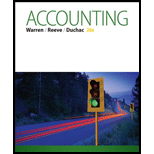
1.
Bonds: Bonds are long-term promissory notes that are represented by a company while borrowing money from investors to raise fund for financing the operations.
Common stock: It refers to a security issued in a form of certificate and implies the right of ownership of an investor over a portion of company’s earnings and assets.
Earnings per Share: It is a portion of profit that is earned by each common stock.
Formula:
To Determine: Earnings per share of common stock for each plan, if income before bond interest and income tax is $2,100,000.
2.
Earnings per share of common stock for each plan, if income before bond interest and income tax is $1,050,000.
3.
To describe: The advantages and disadvantages of each plans.
Trending nowThis is a popular solution!

Chapter 14 Solutions
Bundle: Accounting, Loose-Leaf Version, 26th + LMS Integrated for CengageNOW, 2 terms Printed Access Card
- Which of the following is a current asset? A) LandB) BuildingsC) Accounts receivableD) EquipmentCorrarrow_forwardWhich of the following is a current asset? A) LandB) BuildingsC) Accounts receivableD) Equipment needarrow_forwardWhich of the following is a current asset? A) LandB) BuildingsC) Accounts receivableD) Equipmentarrow_forward
- Which accounting principle requires that expenses be recorded when incurred, regardless of when cash is paid? A) Matching principleB) Revenue recognition principleC) Cost principleD) Going concern principleNo aiarrow_forwardWhich accounting principle requires that expenses be recorded when incurred, regardless of when cash is paid? A) Matching principleB) Revenue recognition principleC) Cost principleD) Going concern principlearrow_forwardWhich of the following statements is true about a balance sheet? A) It shows the financial performance of a company over a specific period of timeB) It includes revenue and expensesC) It lists assets, liabilities, and equityD) It is prepared only at the end of the yearcorarrow_forward
- Which of the following statements is true about a balance sheet? A) It shows the financial performance of a company over a specific period of timeB) It includes revenue and expensesC) It lists assets, liabilities, and equityD) It is prepared only at the end of the year need nelparrow_forwardWhich of the following statements is true about a balance sheet? A) It shows the financial performance of a company over a specific period of timeB) It includes revenue and expensesC) It lists assets, liabilities, and equityD) It is prepared only at the end of the yeararrow_forwardThe normal balance of an asset account is: A) DebitB) CreditC) None of the aboveD) Both debit and credit correct answerarrow_forward
- The normal balance of an asset account is: A) DebitB) CreditC) None of the aboveD) Both debit and creditarrow_forwardThe normal balance of an asset account is: A) DebitB) CreditC) None of the aboveD) Both debit and creditneedarrow_forwardWhich of the following is considered a long-term liability? A) Accounts payableB) Unearned revenueC) Bonds payableD) Wages payable correct answerarrow_forward
 Survey of Accounting (Accounting I)AccountingISBN:9781305961883Author:Carl WarrenPublisher:Cengage Learning
Survey of Accounting (Accounting I)AccountingISBN:9781305961883Author:Carl WarrenPublisher:Cengage Learning Financial Accounting: The Impact on Decision Make...AccountingISBN:9781305654174Author:Gary A. Porter, Curtis L. NortonPublisher:Cengage Learning
Financial Accounting: The Impact on Decision Make...AccountingISBN:9781305654174Author:Gary A. Porter, Curtis L. NortonPublisher:Cengage Learning Financial AccountingAccountingISBN:9781337272124Author:Carl Warren, James M. Reeve, Jonathan DuchacPublisher:Cengage Learning
Financial AccountingAccountingISBN:9781337272124Author:Carl Warren, James M. Reeve, Jonathan DuchacPublisher:Cengage Learning Managerial Accounting: The Cornerstone of Busines...AccountingISBN:9781337115773Author:Maryanne M. Mowen, Don R. Hansen, Dan L. HeitgerPublisher:Cengage Learning
Managerial Accounting: The Cornerstone of Busines...AccountingISBN:9781337115773Author:Maryanne M. Mowen, Don R. Hansen, Dan L. HeitgerPublisher:Cengage Learning Financial AccountingAccountingISBN:9781305088436Author:Carl Warren, Jim Reeve, Jonathan DuchacPublisher:Cengage Learning
Financial AccountingAccountingISBN:9781305088436Author:Carl Warren, Jim Reeve, Jonathan DuchacPublisher:Cengage Learning





